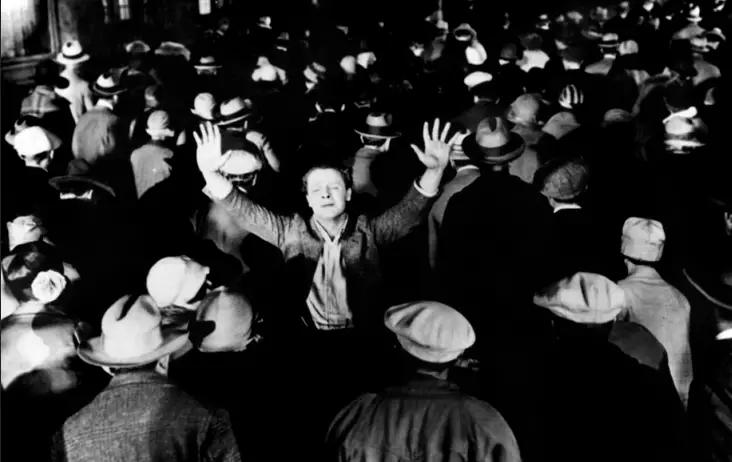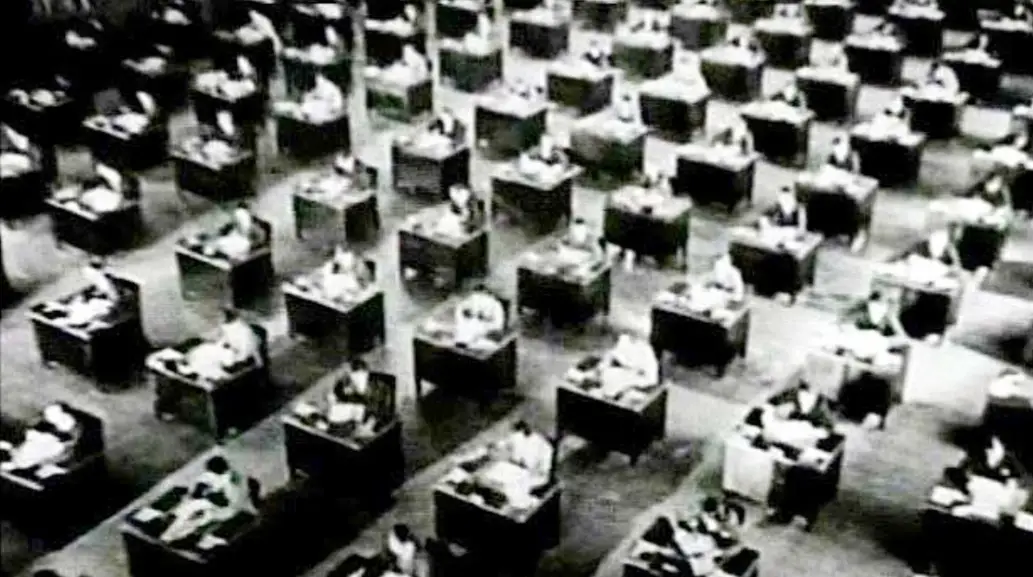
Director: King Vidor
Producer: Irving Thalberg (MGM)
Writers: King Vidor and John V.A. Weaver (screenplay)
Photography: Henry Sharp
Music: Carl Davis
Cast: James Murray, Eleanor Boardman, Bert Roach, Estelle Clark, Daniel G. Tomlinson, Dell Henderson, Lucy Beaumont, Freddie Burke Frederick, Alice Mildred Puter
![]()
Introduction
After directing the highest grossing silent movie ever in The Big Parade (1925), King Vidor inked a long-term deal with MGM, where producer Irving Thalberg allowed him enormous artistic freedom for his next project. According to Vidor’s 1954 autobiography, Thalberg came to him asking what his big follow-up would be, and Vidor described a film about the common struggles of an ordinary man. Thalberg asked, “Well, what are you going to try next? It’s going to be hard to top The Big Parade.” Vidor replied, “Well, I suppose the average fellow walks through life and sees quite a lot of drama taking place around him. Objectively, life is like a battle isn’t it?”
Originally titled One of the Mob, the project eventually became The Crowd, a film detailing the lost promise of the American Dream that so many face, often in urban dwellings. In this atmosphere, it’s not man vs. nature, but man vs. man-made circumstances, both socially — with limited class mobility — and physically — trapped in the proverbial “concrete jungle.” It was his most personal work, far less successful at the box office, but far more renowned by academics decades later. Thus, The Crowd stands as the art masterpiece that got its chance off the success of The Big Parade blockbuster, the expression of the one after the cheers of the mob, epitomizing the very notion of The Film Spectrum.
![]()
Plot & Themes
Just as The Big Parade was about an ordinary man’s individual journey through WWI, The Crowd tackles another look at an individual, this time named John Sims (James Murray), who’s born on the Fourth of July (I wonder why Oliver Stone got the idea for Tom Cruise). John is promised by his father that he will do “something big,” learning the arts “like Lincoln and Washington,” so at age 21, he takes off for New York, despite being told his slim odds: “You’ve gotta be good in that town if you want to beat the crowd.”
All he wants is an opportunity, he says, landing a desk job as just one among millions. Here, a co-worker introduces him to his bride-to-be, Mary (Eleanor Boardman), but this is no wonderful life. The rest of the film depicts his gradual transformation from naive dreamer to hardened urban cynic, smothered by the sheer numbers around him. At work, he is just a number — #137 to be exact — and is addressed by co-workers in mocking cliche, long before Office Space (1998) had a “case of the Mondays.” We the viewers undergo this journey with him, ourselves feeling like one among millions.
“I believe in subjective reality, that every man makes his own universe,” Vidor said. “… By sharing his life and his emotions you would then know that all others are more or less the same. Pick out one of the mob, one of the crowd, and follow him, and he’d go through the same emotions and same experiences as other people.” (B)
![]()
Tragic Cast
With such attention to the individual, Vidor needed to cast the two leads just right. For his female lead, he chose his wife, Eleanor Boardman, who mothered two of his children and gives a superb performance here. Still, the film belongs to Murray, whom Vidor cast immediately.
“I had pictured the guy so often in my mind that when I saw a fellow who looked like that image I said, ‘That’s it. He’s perfect for the role.’ I had a vision of an ordinary average man, and saw a bunch of extras walking out of the studio one day. I saw the face of one guy, James Murray, and I chased after him.” (B)
The choice was dead-on, as Murray gave a magnificently somber performance, one so good that many say he never got over his character’s urban depression. By the 1930s, Murray was a chronic alcoholic living on the streets and begging for change. In 1934, Vidor offered him a role in Our Daily Bread, a similar film reprising the characters of John and Mary Sims, but Murray refused to take the charity, perhaps not wanting to remind himself of his own suffering. (B) Two years later, at the young age of 35, his body was found in the Hudson River in an apparent suicide, a tragic death that so haunted Vidor that he wrote a script about it called The Actor in 1979, a project that never made it to the screen.
![]()
Depressed Reaction
In 1928, Audiences reacted similarly to Murray, as they could not connect with The Crowd as they overwhelmingly had with The Big Parade. They found it too downbeat and too depressing, cutting against the grain of the lavish Roaring 20s mindset. Would the film have done better if it were released a year later, after the Wall Street Crash of 1929? Would The Crowd have provided solace during the Great Depression, as The Grapes of Wrath (1940) would 12 years later?
Either way, MGM tried combating the downbeat themes by tacking on a happy ending, where the family wins a fortune, similar to the ending of F.W. Murnau’s The Last Laugh (1924). Still, in the end, Vidor’s more realistic vision ultimately triumphed.
“Not everyone can be winners,” Vidor said. “This is why I think the ending where the camera pulls back and he’s lost in the crowd is a realistic ending. The other endings with him prosperous and happy were false.” (B)
![]()
Artistic Expression
Despite the lackluster audience reaction, the film has found legs after decades of academic study, with critics praising it as an artfully-made, socially conscious picture. From the very start, Thalberg referred to the film as Vidor’s “experimental” work, arriving at the peak of his creativity for visual storytelling, released just a year before his first sound film, Hallelujah! (1929). The Crowd earned five Oscar nominations at the very first Academy Awards, including Best Director (losing to Frank Borzage for Seventh Heaven) and Best Unique and Artistic Production (losing to F.W. Murnau’s Sunrise).
There is, of course, no shame in losing to Sunrise, which remains arguably the pinnacle of the silent era, but Vidor easily should have topped Borzage for the directing statue. In The Crowd, we begin to see the early seeds of what has since become The Auteur Theory, which Vidor himself keenly articulated.
“I’m a firm believer in the fact that you put your individual stamp on your work,” Vidor said. “I think the whole job is to show one’s individual viewpoint. … Over the years I have learned that things will be dug out of your unconscious.” (B)
Indeed, Vidor is one of cinema’s earliest auteurs, expressing his social commentary with a number of groundbreaking techniques. Note the forced perspective of Young John climbing a staircase toward the tragedy of his dead father; the camera sliding backward down a slide on Coney Island; the editing during the couple’s tragedy; and that wonderful image of Murray standing in the middle of a huge crowd, looking up with his eyes closed and hands raised, palms open, as if pleading for an escape.
Most of all, note the camera’s impressionistic tilt to scale up the side of a building, accomplished by tracking over a 15-foot miniature lying flat on a soundstage. The building looks obviously fake by today’s standards, but it’s the concept that counts! These are first-time ideas on expanding the visual medium, accomplished without CGI. Due to the limitations imposed by early sound filming techniques, the film’s moving camera innovations would not be equaled for another decade.
Moments later, as the camera moves in through the window, it swoops in over a massive room of office desks, focusing in on our solo hero. This shot alone was heavily influential on Billy Wilder’s introduction of Jack Lemmon in The Apartment (1960). (C)

![]()
Legacy
The Crowd is undoubtedly considered one of the first landmarks in all of cinema, echoed in the styles of countless greats to follow. Italian filmmaker Vittorio De Sica told Vidor that The Crowd influenced his own masterworks, Bicycle Thieves (1948) and Umberto D (1952), and deserves credit for starting the entire movement of Italian Neorealism. (B)
Later, when the French New Wave took hold in Paris, legendary French director Jean Luc Godard (Breathless, Band of Outsiders) was asked why more films were not made about ordinary people. His response: “Why remake The Crowd? It has already been done.”
The film was deemed so important that in 1989, the Library of Congress chose it as one of the original 25 films to preserve in the National Film Registry. Vidor boasts the longest career of any director at 67 years, with films in more than eight decades. (A) He also has a film festival that carries his name in Galveston, where at age six, he survived the deadliest hurricane in U.S. recorded history. How fitting that such a festival will provide a platform for aspiring auteurs to accept a challenge he made back in 1977: “I think the most important [films] do have the continuity of the individual. But how many directors today achieve that?” (B)
![]()
Citations:
CITE A: Turner Classic Movies, Felicia Feister’s review of Our Daily Bread (1934)
CITE B: George Stevens Jr, Conversations with the Great Moviemakers of Hollywood’s Golden Age
CITE C: Roger Ebert’s “Great Movies” review of Billy Wilder’s The Apartment
